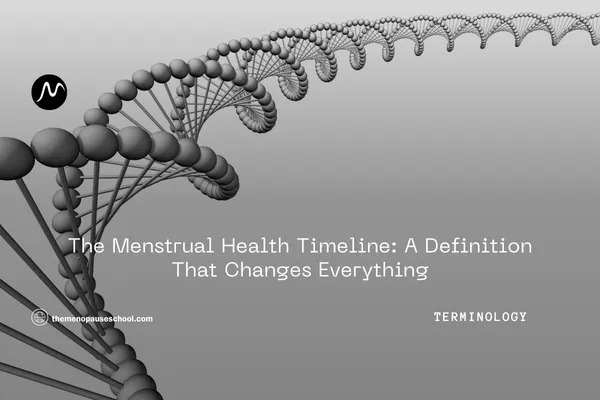Articles & Information
BLOG

The Menstrual Health Timeline
The menstrual health timeline doesn’t start with a first period. It begins far earlier—at the very start of life—when two chromosomes unite, and a pair of tiny ovaries begin to form.
By around 20 weeks in utero, the ovaries contain approximately 6 to 7 million immature egg cells (oocytes). From that point onward, no new eggs are produced. After that, the number steadily declines. The rest of the journey—birth, puberty, menstruation, perimenopause, menopause—is shaped by the gradual, natural process of ovarian ageing (aka atresia).
This isn’t a decline. It’s a timeline. One that runs through every phase of a menstruator’s life, often silently shaping physical health, mood, energy, and more.
Yet most people don’t learn about it. Health education often separates periods & reproduction from menstrual health and the timeline —as if they belong to different bodies. But the truth is, they’re part of the same story.
Here’s the simplified structure:
In utero: Ovaries are formed and egg reserve is set.
Childhood to puberty: Ovarian hormones are dormant until activated by the brain.
Menstruating years: Cycles are guided by fluctuating oestrogen and progesterone.
Perimenopause: A time of unpredictable changes in ovarian activity, where hormonal rhythms become irregular as the egg reserve reaches around 25,000. Endocrinologists call this number the tipping point of accelerated ovarian ageing.
Menopause: Defined by 12 months without a period, signalling the end of ovulation.
Postmenopause: A hormonally distinct stage, influenced by the full legacy of the timeline before it.
Why does this definition matter?
Because understanding the full menstrual health timeline helps us see patterns, not problems. It replaces fear with awareness. And it helps us meet the real needs of menstruators—whether they're 14, 44, or 64.
Ovarian ageing is not a new phenomenon. It’s a biological process with somewhat predictable phases, also known as a continuum. If we taught this from the start, people would have the language, tools, and support to understand their bodies over a lifetime.
That’s why we teach it at The Menopause School—and why this definition sits at the heart of everything we do.

The Menstrual Health Timeline
The menstrual health timeline doesn’t start with a first period. It begins far earlier—at the very start of life—when two chromosomes unite, and a pair of tiny ovaries begin to form.
By around 20 weeks in utero, the ovaries contain approximately 6 to 7 million immature egg cells (oocytes). From that point onward, no new eggs are produced. After that, the number steadily declines. The rest of the journey—birth, puberty, menstruation, perimenopause, menopause—is shaped by the gradual, natural process of ovarian ageing (aka atresia).
This isn’t a decline. It’s a timeline. One that runs through every phase of a menstruator’s life, often silently shaping physical health, mood, energy, and more.
Yet most people don’t learn about it. Health education often separates periods & reproduction from menstrual health and the timeline —as if they belong to different bodies. But the truth is, they’re part of the same story.
Here’s the simplified structure:
In utero: Ovaries are formed and egg reserve is set.
Childhood to puberty: Ovarian hormones are dormant until activated by the brain.
Menstruating years: Cycles are guided by fluctuating oestrogen and progesterone.
Perimenopause: A time of unpredictable changes in ovarian activity, where hormonal rhythms become irregular as the egg reserve reaches around 25,000. Endocrinologists call this number the tipping point of accelerated ovarian ageing.
Menopause: Defined by 12 months without a period, signalling the end of ovulation.
Postmenopause: A hormonally distinct stage, influenced by the full legacy of the timeline before it.
Why does this definition matter?
Because understanding the full menstrual health timeline helps us see patterns, not problems. It replaces fear with awareness. And it helps us meet the real needs of menstruators—whether they're 14, 44, or 64.
Ovarian ageing is not a new phenomenon. It’s a biological process with somewhat predictable phases, also known as a continuum. If we taught this from the start, people would have the language, tools, and support to understand their bodies over a lifetime.
That’s why we teach it at The Menopause School—and why this definition sits at the heart of everything we do.

The Menstrual Health Timeline
The menstrual health timeline doesn’t start with a first period. It begins far earlier—at the very start of life—when two chromosomes unite, and a pair of tiny ovaries begin to form.
By around 20 weeks in utero, the ovaries contain approximately 6 to 7 million immature egg cells (oocytes). From that point onward, no new eggs are produced. After that, the number steadily declines. The rest of the journey—birth, puberty, menstruation, perimenopause, menopause—is shaped by the gradual, natural process of ovarian ageing (aka atresia).
This isn’t a decline. It’s a timeline. One that runs through every phase of a menstruator’s life, often silently shaping physical health, mood, energy, and more.
Yet most people don’t learn about it. Health education often separates periods & reproduction from menstrual health and the timeline —as if they belong to different bodies. But the truth is, they’re part of the same story.
Here’s the simplified structure:
In utero: Ovaries are formed and egg reserve is set.
Childhood to puberty: Ovarian hormones are dormant until activated by the brain.
Menstruating years: Cycles are guided by fluctuating oestrogen and progesterone.
Perimenopause: A time of unpredictable changes in ovarian activity, where hormonal rhythms become irregular as the egg reserve reaches around 25,000. Endocrinologists call this number the tipping point of accelerated ovarian ageing.
Menopause: Defined by 12 months without a period, signalling the end of ovulation.
Postmenopause: A hormonally distinct stage, influenced by the full legacy of the timeline before it.
Why does this definition matter?
Because understanding the full menstrual health timeline helps us see patterns, not problems. It replaces fear with awareness. And it helps us meet the real needs of menstruators—whether they're 14, 44, or 64.
Ovarian ageing is not a new phenomenon. It’s a biological process with somewhat predictable phases, also known as a continuum. If we taught this from the start, people would have the language, tools, and support to understand their bodies over a lifetime.
That’s why we teach it at The Menopause School—and why this definition sits at the heart of everything we do.
a free practitioner's guide
Menstrual Health 101
Key insights
Your First Step to a Cycle-Aware Practice

Start making a real impact today.

Why You Need This Guide
Explore how hormonal rhythms influence metabolism, mood, and well-being at every life stage
Discover how small, practical shifts in your approach can enhance client outcomes, build trust, and set you apart in your field.


